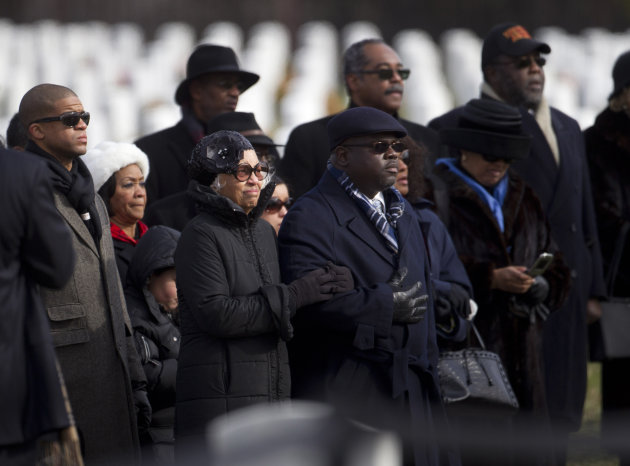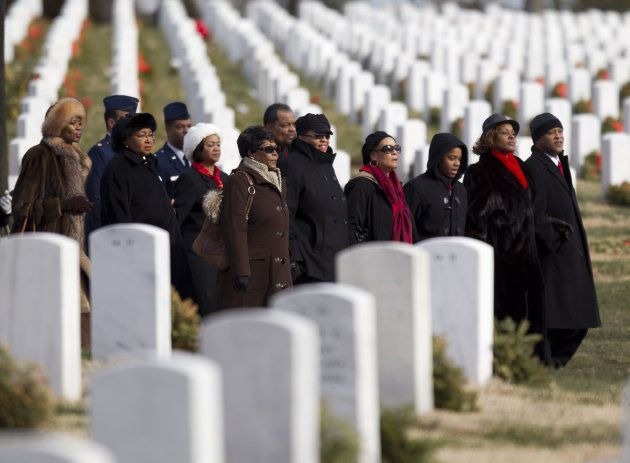
ARLINGTON, Va. (AP) ? On the same day that retired Air Force Lt. Col. Luke Weathers Jr. took his resting place among other war and military heroes, his real-life story as a World War II aviator played out on movie screens across the country.
Weathers was buried Friday at Arlington National Cemetery in a service that began with a flyover of four F-16 jets in the Missing Man formation, a special honor reserved for pilots, by the 113th Wing of the D.C. Capital Guardians, the same unit that guards the airspace over the nation's capital.
Weathers died Oct. 15 in Tucson, Ariz., of pneumonia at age 90. His burial coincided with the official opening in theaters of "Red Tails," a George Lucas-produced movie retelling the story of the Tuskegee Airmen who debunked widely held beliefs that black pilots were incapable of fighting in combat.
Shortly after the flyover, in which one of the three jets departed from formation, a caisson pulled by six horses carried Weathers' body to his burial spot amid hundreds of the stark marble tombstones that cover the grounds of the national cemetery. An Air Force band accompanied the wagon, its drummer thumping a solemn beat as family followed on the chilly, overcast Friday morning. Family members wore red ties and scarves, as they had at Weathers' Memphis funeral, as a nod to the aviators who painted their aircrafts' tails red to set themselves apart.
Luke Weathers III, 61, said his father and other black Americans who fought in World War II did so to prove they were men, "and then they wanted their country to love them, but that didn't happen, either." Friday's ceremony, however, finally delivered recognition of his father as a national hero, Weathers said.
This kind of attention to the Tuskegee Airmen is what the elder Weathers wanted throughout his life, said his daughter, Trina Weathers Boyce. Weathers was not vain, but he wanted to share the lessons of the airmen's courage in war, their struggles for equality and their victory over a wartime enemy and over racism, she said.
"He would talk about his hard trials and tribulations to others, to children, because he never wanted us to feel like this (racism) is a reason we couldn't make it," Weathers Boyce said in a telephone interview Thursday. "He would tell us nothing good comes easy. He'd say there are going to be barriers ... and you can overcome them."
Before the Tuskegee Airmen were formed in 1941, black men were forbidden to fly for the U.S. military, even though they could be drafted. After years of struggle, the Army Air Corps began to allow African Americans to train for flight, albeit in still-segregated units.
Many of the tens of thousands of Tuskegee airmen, which included navigators, mechanics, medical personnel and others in support roles, trained from 1941 to 1949 at the Tuskegee Institute, which was founded by Booker T. Washington and was already home to an aeronautical engineering program. In the home state of the institute, Alabama Gov. Robert Bentley signed a proclamation honoring the airmen, saying they changed Americans attitudes about race relations.
More than 900 Tuskegee Airmen were U.S. pilots, said Trent Dudley, an Air Force lieutenant colonel who is president of the East Coast Tuskegee Airmen Inc. chapter. An estimated 250 to 300 Tuskegee airmen are still alive. The exact number is not known because some have not registered with chapters.
"As with all the airmen, when we lose one of them, there is a chunk of history that goes with them," Dudley said.
Defying social norms was already a family trait when Weathers was born in Grenada, Miss.
At the time, the town's railroad track served as the economic dividing line. Weather's mixed-race father and black mother defied that dividing line, which led them to move to Memphis, where they opened their own grocery store.
Years later, Weathers was studying biology at Lane College in Jackson, Tenn., when he stumbled on an article in an international newspaper about the Tuskegee Experiment, the federal government's name for the Army Air Corps training of African Americans, Weathers Boyce said.
His mother turned to the prominent Memphis family she worked for and, with the help of the family's connections, Weathers was considered and eventually accepted into their program.
He always talked about the maneuver that save his life, Weathers Boyce said. A skillful pilot, he was a target of the Germans. In one combat flight, German aircraft were pursuing him and firing. He was forced to dip down and make a few turns in his plane to keep from getting shot, she said.
Weathers flew P-51 and P-39 fighters during his service from 1942 to 1945 and earned a Distinguished Flying Cross, according to the National Guard Bureau. He and other Tuskegee Airmen were awarded the Congressional Gold Medal in 2007.
After the war, Weathers went on to become the first African American air controller, run a coin-operated laundry, raise five children, open a flight school, provide vocational rehabilitation for veterans and write a book about his life story that has not yet been published, Weathers Boyce said.
"We are still educating people on the Tuskegee history," Weathers said, "because it's a big part of American history, not African American or black history, but American history."
___
Online:
Arlington National Cemetery: http://www.arlingtoncemetery.mil/
___
Suzanne Gamboa can be reached at http://www.twitter.com/APsgamboa

kelly clarkson empty nest braveheart nbc sports bengals vs texans nfl playoffs cincinnati bengals
No comments:
Post a Comment
Note: Only a member of this blog may post a comment.